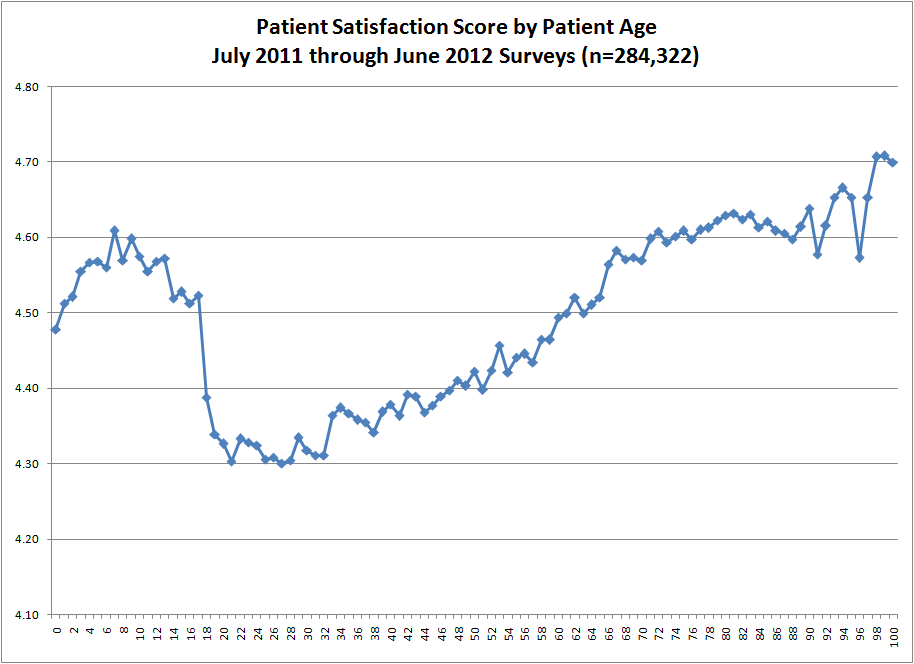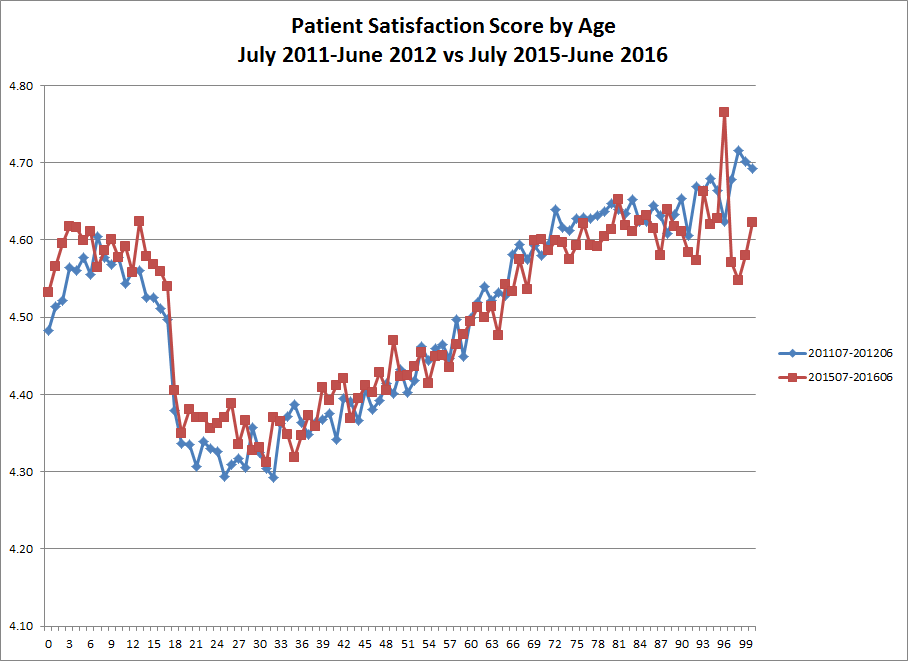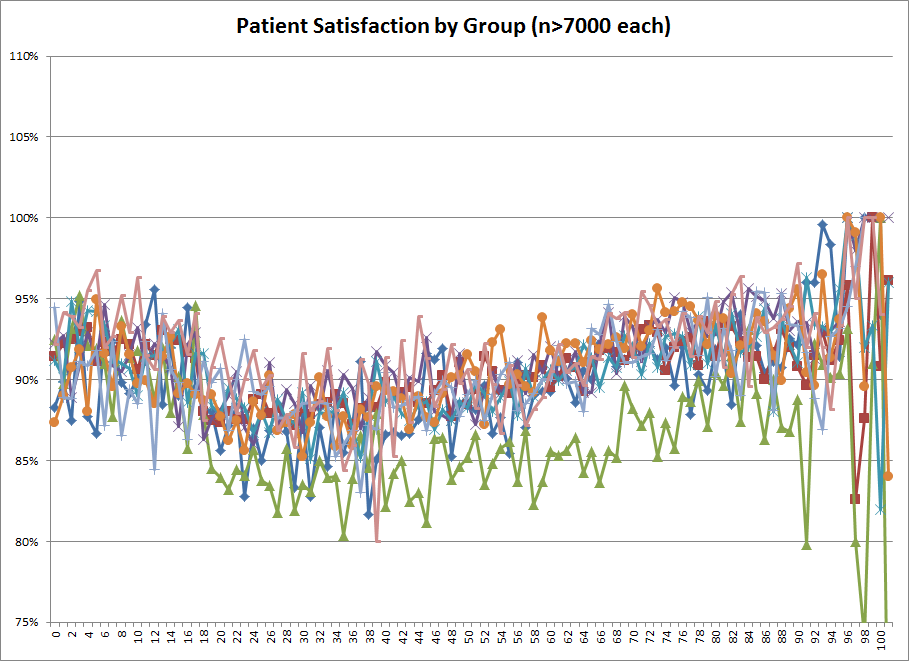Patient satisfaction has become an important measure of health quality and has been tied to reimbursements in the Hospital Value-Based Purchasing (HVBP) model by CMS.
Beyond its intrinsic importance as an indicator of quality, these financial implications make improving patient satisfaction an issue that merits the attention of hospital leadership.
A seldom discussed driver of patient satisfaction is the patient's age. However, data collected from across the nation suggests that age may be a larger factor in patient satisfaction than previously thought. Research conducted by Intermedix, a revenue cycle and practice management company, over a 12 month period on more than 284,000 patient satisfaction surveys gathered from ER visits around the country has revealed a staggering correlation on the impact that a patient's age has on their overall satisfaction score.
Regardless of sample size and location, the results are consistent and reveal several trends: pediatric patients (or rather their parents) tended to score higher, young adults ages 18-26 consistently scored the lowest, followed by a positive linear progression in correlation with a patient's age.
Millennials, young adults ages 18-30, proved on average to be significantly more dissatisfied with their experience at hospitals and health systems than any other demographic.
Why is this the case?
Several theories have been posed that may explain the findings.
The first theory: millennials are the need-it-now, fast-food generation so used to instant gratification that the care structure in hospital emergency departments doesn't meet their perceived needs. However, this seems to be too simplistic of an answer that is built on the negative perceptions of the generation.
The second, and my preferred theory is that there is an inherent friction that exists between millennials who may be experiencing anxiety in an unfamiliar emergency room setting and the busy providers who have little patience for the relatively healthy millennial patients.
When patients in this younger demographic utilize emergency department services, odds are higher that it is their first time there without a parent, which can be intimidating. When millennials admit themselves to the ED, it's often because of a health situation that they typically don't know very much about, which can be a scary situation.
On the other hand, providers in the emergency department don't typically have a lot of patience for patients that are relatively healthy – and 18-30 year olds are overall comparatively healthy. There's an inherent tension between a young patient alone for the first time in a big scary new environment and providers moving around that don't have time to mess with them.
According to data from Medscape, compared to other specialists, emergency medicine physicians reported the highest percentage of biases toward patients at 14 percent. Biases are triggered by various patient characteristics and can be correlated with these physicians that reported feelings of being burned out.
Physicians may report to having less patience with younger demographics, yet this study displays that these patients are overall receiving a more positive treatment experience, demonstrating that there are other factors contributing to the decline of patient satisfaction.
So why do we need to better millenials' experiences in the ER?
To assess patient satisfaction, CMS and the Agency for Healthcare Research and Quality have created the 32 item Hospital Consumer Assessment of Healthcare Providers and Systems (HCAHPS) Survey. The survey measures patients' perceptions of their care experience during a recent hospitalization.
In 2016, 25 percent of hospitals' performance scores were used to calculate Medicare incentive payments based upon the HCAHPS.
Although the plus/minus 5 percent variation in score, on figure 1 below, doesn't seem like a big swing, that variation is the difference between scoring in the 15th percentile and 85th percentile on national patient satisfaction score



It doesn't take much to have a big impact on percentile standing. Although patient age is not a factor hospitals can change, it is important for hospital administration to understand the impact and look for effective ways to accommodate this growing population.
A plus/minus 5 percent shift in satisfaction scores could carry major implications in today's consumer-driven healthcare industry, in which patient experience is playing an increasingly significant role. Satisfaction scores are already tied to HVBP reimbursements and are starting to carry greater weight among patients when selecting which facility to seek treatment, contributing to greater competition between regional facilities.
Progressive hospitals would be wise to consider the unexpected drivers that impact patient satisfaction, such as patient age, when developing a patient-centric approach to overall experience if they wish to remain competitive and avoid losing revenue.
Justin Schaper is the Senior Vice President of Analytics at Intermedix. With a focus on improving provider performance and organizational operations, Schaper oversees the organization's predictive and prescriptive analytics tools and services. He has 28 years of information technology experience. Prior to joining Intermedix, Schaper held the position of Chief Information Officer at PSR. Schaper studied theoretical physics at the University of Colorado Boulder.
The views, opinions and positions expressed within these guest posts are those of the author alone and do not represent those of Becker's Hospital Review/Becker's Healthcare. The accuracy, completeness and validity of any statements made within this article are not guaranteed. We accept no liability for any errors, omissions or representations. The copyright of this content belongs to the author and any liability with regards to infringement of intellectual property rights remains with them.

